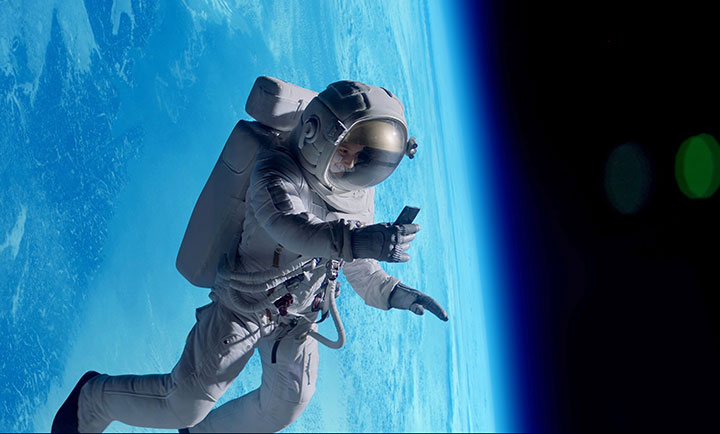
ALEXANDRIA, Va. — In Gartner’s Hype Cycle, the “Peak of Inflated Expectations” is followed by the “Trough of Disillusionment.” For satellite-to-cellular realists, these peaks and troughs have not been terribly dramatic. Realists understood that, yes, a person stranded on a desert island will be able to send an SOS message via satellite but they won’t be streaming season 46 of “Survivor.”
For those whose expectations are still soaring, 2024 may feel like déjà vu. Within some technology circles, there are renewed claims that this will be the year of satellite-connected smartphones. 2024 has already kicked off with promising developments. But questions remain. Will a single business model lead to a market breakthrough? Will the evolution of 3GPP standards or spectrum strategies give satellite a more prominent position in consumer mobile technology? Will 2024 be a year of continued hype or will the technology keep progressing along the “Slope of Enlightenment”?
SpaceX, Lynk and AST Start 2024 on a High Note
One of the most significant satellite direct-to-device (D2D) developments in the new year was SpaceX sending and receiving its first text message via satellite. SpaceX, which announced plans to connect T-Mobile subscribers back in 2022, has agreements with five other operators—Japan’s KDDI, Australia’s Optus, One NZ in New Zealand, Rogers in Canada and Salt in Switzerland. The demonstration utilized using T-Mobile network spectrum and accompanied the announcement that SpaceX would increase its sat-to-cell launch cadence in the coming months. In response, T-Mobile CEO Mike Sievert commented that satellite-based text messaging could be available to network subscribers sometime this year.
Lynk Global, which activated its satellite SMS service in 2023, also achieved a milestone—right on the cusp of the new year. The soon-to-be-public company successfully completed its first voice call via satellite with Rogers of Canada using an unmodified cellular handset. AST SpaceMobile also made strides when it raised $300 million from Google, AT&T and Vodafone, among others, to support the commercial roll-out of its satellite direct-to-device network.
While many of the biggest developments in sat-to-cell failed to materialize in the timeframe that consumer technology enthusiasts had hoped for—or hyped for—2023 was a critical year for charting the path forward.
Settling on Standards
Possibly one of the most disappointing developments in sat-to-cell was the collapse of the Iridium-Qualcomm deal. The two companies signed an agreement last January to make Snapdragon chips for Android phones with emergency satellite SOS service, comparable to Apple and Globalstar’s iPhone service. Just 10 months later, Qualcomm scrapped the deal citing a lack of interest from phone makers. Even with decades of experience with satellite phones and a constellation of more than 60 satellites, Iridium’s proprietary technology solution turned out to be a difficult sell. In a recent press release, Iridium CEO Matt Desch acknowledged that the “industry is moving quickly towards a more stands-based approach.”
At last month’s CES consumer electronics expo, Iridium COO Suzi McBride told an audience that the company “pivoted” from their proprietary approach to a “standards-based solution.” The new solution, called Project Stardust, will be based on NB-IoT—the narrowband technology standard for cellular and connected devices developed by 3GPP for 5G non-terrestrial networks (NTN). Stardust will leverage Iridium’s LEO constellation and its allocated L-band spectrum to provide proprietary, standards-based or dual-approach connectivity solutions for SOS capabilities on smartphones, connected cars and other devices.
 CES 2024 featured a satellite technology track including a panel on satellite-to-cellular device connectivity featuring (left to right) Sumaiya Najarali of Euroconsult, Iridium Communications COO Suzi McBride, Lynk Global CTO Tyghe Speidel, Omnispace Vice President of Strategy George Giagtzoglou and Nokia Mobile Networks Americas CTO Robert Backhouse. (Source: Consumer Technology Association/CES)
CES 2024 featured a satellite technology track including a panel on satellite-to-cellular device connectivity featuring (left to right) Sumaiya Najarali of Euroconsult, Iridium Communications COO Suzi McBride, Lynk Global CTO Tyghe Speidel, Omnispace Vice President of Strategy George Giagtzoglou and Nokia Mobile Networks Americas CTO Robert Backhouse. (Source: Consumer Technology Association/CES)
Many direct-to-cell and D2D providers have settled on 3GPP standards. Since the protocols were designed to integrate the global mobile telecommunications community, they’re viewed as arguably the best route for satellite operators and vendors to reach the largest addressable market. Lynk, OmniSpace and SpaceX all boast services that work with standard, unmodified mobile phones on select networks using 3GPP standards. “Our strength is things like 3GPP, standards-based [communications],” said Nokia CTO of Mobile Networks Americas Robert Backhouse during a CES panel on D2D technology. “That’s why we partner with the companies who want to provide these solutions.” In 2022, OmniSpace awarded a five-year contract to Nokia to provide the radio technology and network management solutions for its sat-to-cell service.
Owning vs. Sharing Spectrum
While standards appear to be converging on 3GPP NTN, spectrum strategy is a more contentious area. Satellite D2D operators are essentially torn between two options: sharing the terrestrial spectrum allocated to their MNO partners or using their own MSS spectrum.
George Giagtzoglou, Vice President of Strategy at Omnispace, argued that sharing spectrum can lead to terrestrial network interference. In turn, he said MNOs would be forced to create exclusion zones for spectrum reuse over satellite or accept the interference. MNOs “cherish” their capacity, Giagtzoglou said during a CES panel, adding they do not have “spare” capacity to share with satellite operators.
“There are no challenges with the use of band N256, S-band, in the markets that we’re looking to serve,” he continued, referring the slice of spectrum allocated to satellite for NTN connectivity. In markets where S-band is in use, N256, S-band can also be used.
Lynk CTO Tyghe Speidel pushed back, arguing that Lynk’s MNO partners prefer the wholesale model of getting satellite connectivity using the bands their infrastructure is designed to handle. “That’s how you get into market and you get access to the devices.” Speidel commented on the interference issue saying that Lynk’s customers typically have excess capacity at the edge of the network in rural and remote areas and can afford to “take a hit on interference.”
Curb Your Enthusiasm
The future of satellite connectivity in the mobile world depends on who you ask. Some optimists expect rapid growth of more than $50 billion in the coming years. Skeptics cite the lack of broadband capabilities for D2D as a massive revenue hurdle that will take years to overcome. Euroconsult estimates that the direct-to-handset market could hit $1 billion by 2027, connecting roughly 130 million users per month by early next decade. It is clear that there is strong market potential but the timeframes for space technology are wildly different from the average consumer tech.
As CNET mobile reporter David Lumb wrote in December, “The year is poised to end with no other mainstream phones getting satellite texting, let alone voice or video. … It’s a reality check on the hype, including buzz echoed by media, and a recognition that there are more obstacles to tackle before we’re all texting with our smartphones from the middle of nowhere.”
Explore More:
Podcast: Mainstreaming Satellite, Embracing MEF Standards and Enabling Service Delivery
Globalstar: Can D2D Market Justify New Satellite Investments?
Euroconsult: Market Conditions for Success in D2D and IoT Satellite Communication Segments
Podcast: Smartphones, Dead Zones and Cell Towers in Space
